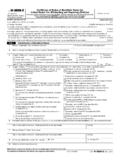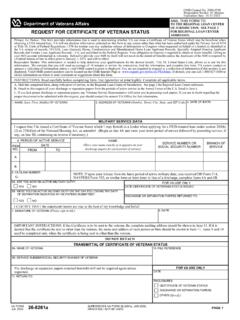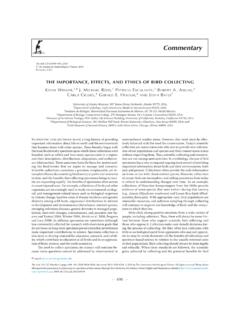Transcription of Disclosure of Beneficial Ownership and Control in …
1 Disclosure of Beneficial Ownership and Control in Listed Companies in Asia 2016 Disclosure of Beneficial Ownership and Control in Listed Companies in Asia 2016 OECD 2016 This work is published under the responsibility of the Secretary-General of the OECD. The opinions expressed and arguments employed herein do not necessarily reflect the official views of OECD member countries. This document and any map included herein are without prejudice to the status of or sovereignty over any territory, to the delimitation of international frontiers and boundaries and to the name of any territory, city or area. FOREWORD Disclosure OF Beneficial Ownership AND Control IN LISTED COMPANIES IN ASIA 2016 OECD 2016 3 Foreword A sound corporate governance infrastructure should combine transparency, accountability and integrity. This requires knowledge of Beneficial Ownership and Ownership and Control structures in listed companies.
2 In line with Chapter 5 of the G20/OECD Principles of Corporate Governance concerning the development of frameworks for Disclosure and transparency, the OECD-Asian Roundtable on Corporate Governance (Asian Roundtable) recognises the need for an adequate regulatory framework for Disclosure of Beneficial Ownership and Control in Asian This report reviews the legal and regulatory landscape for Disclosure of Beneficial Ownership and Control in Asia. It compares enforcement practices in ten Asian jurisdictions and provides guidance and good practices to support policy makers and regulators. The report was discussed by 14 Asian jurisdictions at the 2015 meeting of the Asian Roundtable in Bangkok, Thailand. Established in 1999, the Asian Roundtable serves as a valuable regional platform for exchanging experiences and advancing the reform agenda on corporate governance while promoting awareness and use of the G20/OECD Principles of Corporate Governance in Asia.
3 It brings together policy makers, practitioners and experts on corporate governance from the Asian region, OECD countries and relevant international organisations. The roundtables are co-organised by the OECD and a host Asian country, in partnership with the Government of Japan. This report aims to enhance the effectiveness of regulators and contribute to a culture of transparency by companies, in the interest of protecting investors and creating confidence in markets. It is a useful reference for reform efforts, self-assessment within national systems and for peer reviews at regional level. Beyond Asian Roundtable participating countries, the report could be an important benchmark for other APEC and ASEAN economies. 1 An adequate regulatory framework for Disclosure of Beneficial Ownership and Control in Asian jurisdictions is one of six priority areas identified by the OECD-Asian Roundtable on Corporate Governance in its 2011 report on Reform Priorities in Asia: Taking Corporate Governance to a Higher Level.
4 ACKNOWLEDGEMENTS 4 Disclosure OF Beneficial Ownership AND Control IN LISTED COMPANIES IN ASIA 2016 OECD 2016 ACKNOWLEDGEMENTS This report is a result of work conducted by Erik Vermeulen, Professor of Business & Financial Law, Tilburg Law School. Special thanks to the 10 participating jurisdictions in Asia which invested considerable time completing the survey questionnaires, contributed to discussions and provided comments on earlier drafts. This report was prepared by Fianna Jurdant, Senior Policy Analyst, and Austin Tyler, Junior Policy Analyst, Corporate Affairs Division of the OECD Directorate for Financial and Enterprise Affairs. This report benefited from comments by Christine Uriarte, Counsel, Asia Key Partners, Anti-Corruption Division of the OECD Directorate for Financial and Enterprise Affairs and Valerie Schilling, Senior Policy Analyst, Financial Action Task Force.
5 The OECD would like to thank the Government of Japan for their support of this work. TABLE OF CONTENTS Disclosure OF Beneficial Ownership AND Control IN LISTED COMPANIES IN ASIA 2016 OECD 2016 5 Table of contents About this Report .. 7 1. The Legal and Regulatory Landscape .. 11 Governing laws and regulatory authorities .. 11 The definition of Beneficial Ownership .. 13 The difference between de jure and de facto Beneficial Ownership .. 19 De facto Beneficial Ownership as the common regulatory approach .. 19 Shares held by spouses and children .. 19 Levels of Disclosure of Beneficial Ownership .. 20 Acting in concert .. 20 Trust as shareholder .. 20 Use of Control (enhancing) arrangements .. 21 Disclosure obligations by service providers .. 23 2. Compliance and Enforcement .. 25 Accurateness of Disclosure .. 25 Enforcement of laws and regulations on Disclosure of Beneficial Ownership .
6 27 Enforcement proceedings to obtain information .. 28 Penalties for non-compliance of Disclosure 32 Disclosure of enforcement actions/practices .. 34 Collaboration among law enforcement authorities .. 34 3. What is next: Disclosure in Practice .. 37 Annex - Questionnaire on Beneficial Ownership in Listed Companies .. 40 Tables 1. Best practices distilled from the questionnaire survey .. 9 2. Laws, regulations and regulatory authorities .. 12 3. Legal and regulatory framework for Beneficial Ownership Disclosure in Asian countries .. 15 4. Level of Disclosure of Beneficial Ownership .. 23 5. Practices regarding Disclosure of Beneficial Ownership and Control structures .. 26 6. Enforcement of Beneficial Ownership Disclosure rules and regulations .. 30 Figures 1. Interest groups pushing for Beneficial Ownership Disclosure .. 28 2. Penalties for non-compliance with Disclosure obligations.
7 34 ABOUT THIS REPORT Disclosure OF Beneficial Ownership AND Control IN LISTED COMPANIES IN ASIA 2016 OECD 2016 7 About this Report Conventional thinking suggests that investor confidence in financial markets depends, in large part, on the existence of an accurate Disclosure regime that provides transparency in the Beneficial Ownership and Control structures of publicly listed companies. This is particularly important in those corporate governance systems that are characterised by concentrated Ownership , such as Asia or parts of Europe. In such systems, large investors with significant voting and cash flow rights may facilitate long-term growth and firm performance. However, there is a risk that controlling Beneficial owners, with large voting blocks, may also have an incentive to divert corporate assets and exploit opportunities for personal gain (private benefits of Control ), at the expense of minority investors and to the detriment of the best interests of the Consider related party transactions, asset stripping and share dilutions.
8 In responding to this risk, most jurisdictions have passed legislation, mandating shareholders to disclose and report the accumulation of a substantial Ownership of shares. The rationale behind Disclosure requirements seems clear: by alerting minority investors or potential investors to material changes in Control and Ownership structures, allowing them to make a more informed assessment about the company s prospects. However, devising an effective legal framework that facilitates the Disclosure of the ultimate Beneficial owner has not proven Even with a system of Disclosure rules, the true Ownership of a company can remain opaque or, in many cases, difficult or even impossible to establish. Unsurprisingly, this regulatory failure has led to calls for even stricter Disclosure requirements. For instance, the G20 (an international forum of twenty major economies) considers the transparency of Beneficial Ownership of legal persons and arrangements as well as the implementation of the FATF (Financial Action Task Force) standards on this topic as a high priority.
9 During the G20 Summit in Brisbane that was held in November 2014, new High Level Principles on Beneficial Ownership and Transparency were adopted. The Principles, which build on existing international instruments and standards, encourage countries (1) to have a definition of Beneficial owner that captures the natural person(s) who ultimately owns or controls the legal person or legal arrangement, (2) to ensure that Beneficial Ownership and Control information is adequate, accurate, current and accessible, and (3) to have a legal framework that enables national authorities (including law enforcement and prosecutorial authorities, supervisory authorities, tax authorities and financial intelligence units) to participate in information exchange on Beneficial Ownership both domestically and internationally. The importance of Beneficial 2 See Erik Vermeulen, Beneficial Ownership and Control : A Comparative Study Disclosure , Information and Enforcement, OECD Corporate Governance Working Papers, No.
10 7 (2013). 3 See Fianna Jurdant, Disclosure of Beneficial Ownership and Control in Indonesia: Legislative and Regulatory Policy Options for Sustainable Capital Markets, OECD Corporate Governance Working Papers, No. 9 (2013). ABOUT THIS REPORT 8 Disclosure OF Beneficial Ownership AND Control IN LISTED COMPANIES IN ASIA 2016 OECD 2016 Ownership and Control Disclosure is again emphasised in the G20/OECD Principles of Corporate Governance. In light of the recent regulatory developments, the question arises: how do the rules and regulations regarding Beneficial Ownership and Control that are currently included in a country s corporate governance regime compare to the recently introduced principles? In order to answer this question and obtain a better idea about the current legislative and regulatory instruments and practices regarding the Disclosure of Beneficial Ownership and Control in listed companies, a questionnaire survey was conducted among the securities regulators of ten Asian economies.
















